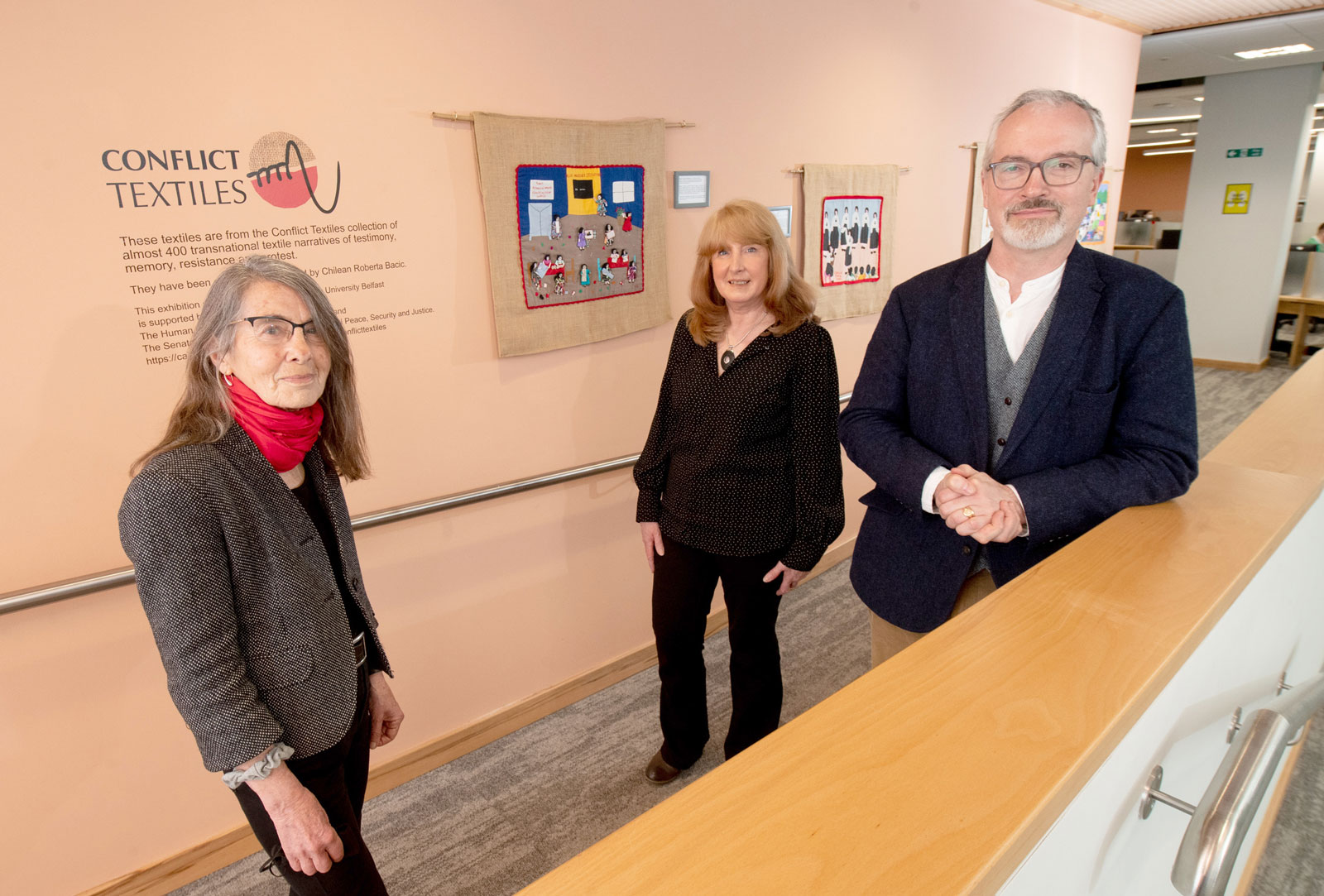Launch of new rotation of Conflict Textiles exhibition
A display of arpilleras from the Conflict Textiles archive was installed at the McClay Library in March 2021

In March 2021, a display of arpilleras from the Conflict Textiles archive was installed at the McClay Library, QUB, supported by the Human Rights Centre and the Senator George J. Mitchell Institute for Global Peace, Security and Justice. This was to be a permanent rotating exhibition and on 6th April, the first rotation took place.
The Conflict Textiles archive comprises a range of textiles, including quilts and wall hangings, but primarily arpilleras. These are embroidered pieces of fabric, mounted on hessian, that depict the impacts of conflict and authoritarianism. They are created to both draw attention to, and condemn, acts of violence, repression, and other human rights violations.
The new selection of textiles
The new selection of textiles is connected by the theme of women’s resistance. This theme speaks directly to the origins of conflict textiles, as these lie with women in Chile, who would come together to make textiles as a way of sharing their stories and challenging the violence and repression of the Pinochet dictatorship. Women’s agency is foregrounded in the new exhibition. While the origins of arpilleras mean that many textiles align with this theme, the four individual pieces selected demonstrate the diverse spectrum of activity that women engage in as a response to violence across different sites of conflict, and the bonds of solidarity that exist across both space and time.
In La Cueca Sola women dance the Chilean national dance - normally danced in pairs - alone and dressed in black, to denounce the actions of the state in disappearing their loved ones. Both Arpilleristas y Cartoneros and Nuestro Taller de Arpilleras depict the arpilleristas themselves. The former is from Chile, and shows women resiliently continuing tasks - including making arpilleras - under the shadow of Pinochet's dictatorship. The latter is from Peru, and in it we see a group of women displaced as a result of the conflict gathering to make arpilleras. Nuestro Taller de Arpilleras is a replica of an original arpillera made in c. 1985 by FCH. The replica was made by the Mujeres Creativas group in Lima, Peru – a group that supports women who were displaced by the conflict in Peru. The making of a replica demonstrates both the present-day support women in the group give to one another, but is also a sign of solidarity with the women who made the original arpillera in the 1980s. The textile NO MAS / No More was made by a group of women in Colombia who were displaced following a massacre in their hometown of Mampuján. In this textile the women imagine an end to violence and the possibility of returning to their home. The inclusion of textiles from Peru and Chile indicates the spread of this form of activism across Latin America. Collectively, these textiles demonstrate the resilience and resistance of women, the strength that comes from solidarity and collective action, and the value of textiles as a way of giving voice to those impacted by violence and repression.
Launch event and exhibition
The launch event was held in the Moot Court, School of Law, and streamed simultaneously online. Prof Richard English, Director of the Senator George J. Mitchell Institute for Global Peace, Security and Justice spoke at the launch:
I think it's a wonderful thing that this Conflict Textiles exhibition is being hosted in Queen's. I think it's been inspiring to walk past the first iteration and it's great to see the new rotation. The Mitchell Institute...is co-funding the exhibition and we are really glad to do so. The Institute examines peace, security, and justice as interwoven themes, and is keen to look at all sorts of different ways of expressing voices - not just the more traditional ways through books and articles and lectures - but through creative, authentic expressions of experience and reflections on human suffering, human resistance, human protest, and human transformation. I think that's a really wonderful way of trying to honour the kind of work that Senator Mitchell himself has done, focusing on relationships, partnership and dialogue. And that's why the Mitchell Institute is delighted to be supporting this in collaboration with the Human Rights Centre at Queen's University.
The exhibition is co-sponsored by the Human Rights Centre. Acting Director of the HRC, Dr Conor McCormick said of the exhibition:
The Human Rights Centre is glad to be supporting the Conflict Textiles Exhibition for a further year. Much like the membership of the Mitchell Institute, our members are keen to support innovative ways of raising awareness about human rights violations around the world. This Exhibition provides an authentic route into some of those difficult conversations for staff and students across the University. I encourage anyone with an interest in art, human rights, or both, to visit the Exhibition when they can, and to share any reflections they might have about what it represents with us.
This selection of textiles will remain in the McClay Library for a year. If you would like to visit the textiles, you can find them on the ground floor, on the left as you approach the Short Loan Collection. There are also a number of textiles on display in the Ulster Museum, as part of the Troubles and Beyond exhibit and the Inclusive Global Histories project.
If you wish to discuss the QUB exhibition, please contact Dr Lauren Dempster (Lauren.Dempster@qub.ac.uk).
Media
If you wish to discuss the QUB exhibition, please contact Dr Lauren Dempster (Lauren.Dempster@qub.ac.uk).
